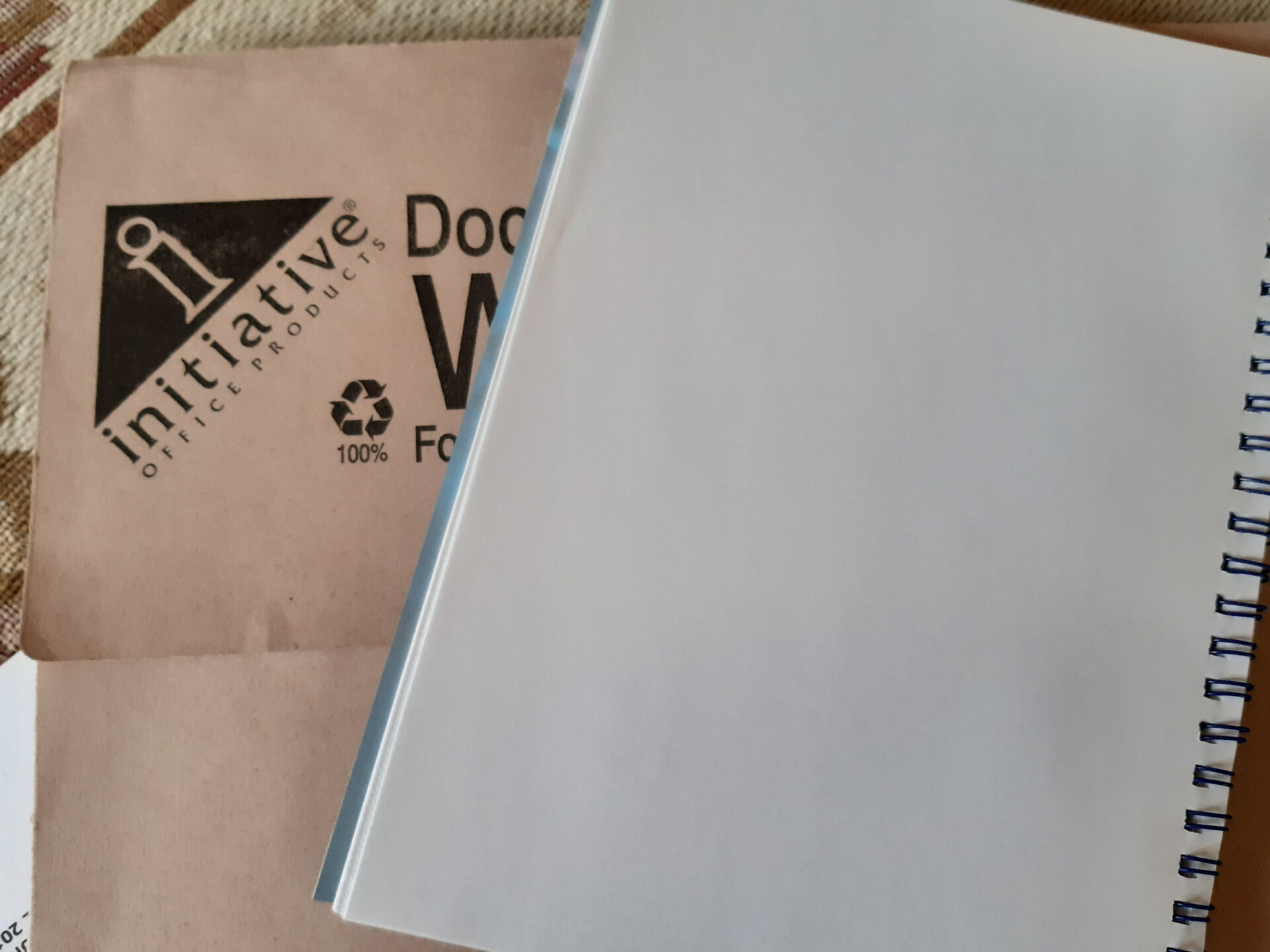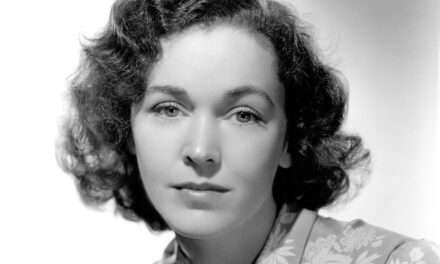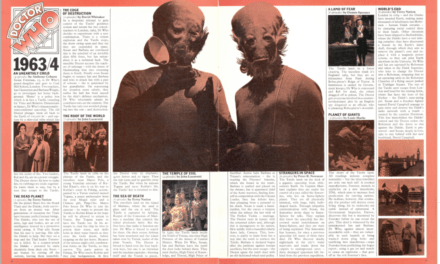<Graeme Garden 1968>DO YOU KNOW what the words starting with ‘D’ and ‘W’ written on this partially obscured file are?

Fig. 1: DO YOU KNOW what the words starting with ‘D’ and ‘W’ written on this partially obscured file are?
Yes – that’s right!
It says ‘Document Wallet’. And now it’s time to Broaden Your Mind!</Graeme Garden 1968>
And so it does Graeme. But the thing is, when my wife and I looked this partially obscured object the other day, we both remarked that we knew that it actually said:
And that’s because it’s something deeply encoded into the DNA of both of us from an early age. We live in a house which contains large quantities of books, scripts, magazines, comics, tapes, discs and Lego devoted to the BBC’s long-running science-fantasy Doctor Who (1963-1989,1996,2005-). It’s a vast part of our lives. Writing about it for about 40 years on an amateur basis has led to us making wonderful friends, travelling to new places, paying homage to those whose work has enriched our lives and – most importantly – meeting each other.
It’s also put food on our table when the professional industries have let us down. So we always try to respect it. And it seems to look after us in return. That’s a bit like religion isn’t it?
Although Doctor Who is a considerable part of our lives and research, it’s something that I deliberately avoid when writing for CSTonline. Many of the notions and concepts that I’ve wanted to convey in previous blogs could have been demonstrated using examples using the words Doctor and Who in that order.
But… I didn’t want to. It would have been too easy. I was aware that Doctor Who is such a popular branding that it would have been lazy of me to use it to underpin on a regular basis. And I think we’re all agreed that from 2006 onwards there was a deluge of academic work on Doctor Who which was disproportionate to its scale. Which makes it all the more important in the interests of balance that we shine some light on some less-well represented series.
If I’m going to talk about Doctor Who, there needs to be a specific, good reason. Now, it’s not actually the best programme I’ve ever seen. Close, but not it. If you’ve read previous blogs, you probably also know it’s not my favourite. But, for my wife and myself, it’s easily the most special.
Is that enough for me to talk about it? Nope. A show being special to two people? So what?
But I think there’s one area in which it is absolutely humping important…
The other week, my wife and I took delivery of our Blu-ray boxed set Doctor Who: The Collection – Season 8 from BBC Studios. Showcaseing the 25 episodes originally broadcast in 1971, this is a thing of beauty which demonstrates why Doctor Who probably has the best commercial release of any television series ever. In terms of restoration, new technology has been specifically developed to fill in missing frames of picture data and to suck trace elements of colour from monochrome films to turn a worn 16mm film image into something closely resembling its original 625-line videotape radiance.
But it’s not just seeing restored examples of the programmes themselves. The five serials come with commentary tracks, documentaries, period continuity, extended unbroadcast edits, contemporary promotional items, raw studio recording and location filming material… one of the adventures has even been lovingly recreated as a Yuletide compilation item, a pacey abridged edition long since deleted from the BBC archives.
These delight-packed sets are assembled by massively talented people – many of them television professionals. The contents are marshalled by Russell Minton, the Head of International Production Consultancy at BBC Worldwide and former producer of broadcasts such as the Eurovision Song Contest (1956-). Lavish documentaries are assembled by people such as Paul Vanezis and Chris Chapman – between them producers and directors of important strands embracing The Sky at Night (1957-) and Countryfile (1988-). Frank Skinner – when not being Lonely in Callan – visits the widow of Doctor Who script editor Terrance Dicks, and broadcaster and historian Matthew Sweet generates a captivating interview with series co-star Katy Manning.
Beyond these items, two other treats are offered by Richard Bignell and Dr Martin Wiggins. Richard curates hundreds of pages of scanned documents included on the discs as PDFs which allow the reader to follow the production from commissioning, via storylines and draft scripts, through planning and budgetary issues, into the day-by-day film schedules, into studio where camera scripts allow a shot-by-shot analysis, then editing and finally transmission with even subsequent global marketing embraced in the paperwork. Martin is a leading scholar of British dramatic history, and an honorary fellow of The Shakespeare Institute in Stratford – and he does not believe that there is any significant difference between what are sometimes termed ‘high’ and ‘low culture’: both are equally deserving of analysis and celebration. As such, he annotates each episode with engaging observations on narrative, production and context to enrich the viewing experience.
So, as a Doctor Who package, we’re agreed. It’s the tops. You can’t do better for this or any other series.
But – wait – it doesn’t end there!
Hang on… Matthew’s not just talking to Katy about her years as the time travelling Jo Grant, he’s asking her about The Golden Road, a very notable 1973 entry in Thames’ Armchair Theatre (1956-1974) anthology. Richard’s paperwork includes production schedules which cover not only Doctor Who but also BBC2’s production of Mrs Gaskell’s Wives and Daughters (1971) and the Lancashire police procedural Z Cars (1962-1965, 1967-1978), while the BBC-1 Television Play Synopses pages also embrace fragments of the film serial adapted from Catherine Cookson’s Joe and the Gladiator (1971). And when a supernatural force spins a signpost to misdirect the Doctor and Jo, Martin’s subtitles highlight a similar device used in The House that Jack Built, a 1966 entry in The Avengers (1961-1969), amongst a host of other nourishing and contextualising treats.
There’s even extracts from the children’s magazine show Blue Peter (1958-) about how television is made at this time. And if you’re still hungry to see how TV was manufactured, what about Behind the Scenes (1971), a documentary about a day at BBC Television Centre? Plus an entire edition of BBC2’s archaeological series Chronicle (1966-1991) from 1968 which presents the original inspiration for one of the Doctor’s most notable adventures.
And so we’re at something which Doctor Who probably does better than any other television series.
It gives a gateway to television history. Suitably for a show about time-travel, it’s a portal to the past.
It’s everywhere. Let’s take something else. Toby Hadoke, one of the big names on the Manchester comedy circuit and a regular contributor to these Blu-ray treats, also presents a superbly assembled Doctor Who podcast entitled Too Much Information. He analyses the show’s episodes one by one – and alongside the time-line of development for each edition, he has assembled captivating biographical histories for the guest cast whose careers intersected with the Doctor’s travels. Thus in The Forest of Fear, we also meet Howard Lang who appeared in BBC2’s stylish comic strip adaptation Jane in the Desert (1984), the Rudolph Cartier-Nigel Kneale collaboration of Albrecht Goes’ Arrow to the Heart (1952) and should be best-remembered as Captain Baines in the maritime period business drama The Onedin Line (1971-1980). Toby reminds us that Eileen Way was also a striking part of Hancock’s Half-Hour (1956-1960), The Newcomers (1965-1969) and Poldark (1975-1977), and that if we want to see more Derek Newark then we should seek out Barlow (1974-1975), Budgie (1971-1972) or Rising Damp (1974-1978). Wow – that’s a lot of television already in that brief paraphrasing.
Now, alongside a career in IT, I’ve also been fortunate enough to spend my free time writing bits for the BBC-licensed Doctor Who Magazine. In January 1988, I was initially approached by its then-editor John Freeman because he wanted me not to write about Doctor Who. He wanted people to understand where Doctor Who fitted in to television history, so he wanted me to inform readers about the earlier ABC serials such as Pathfinders in Space (1960) and explain why these were major landmarks on the road to Doctor Who. And I was delighted – because I think you appreciate all these series far more when given context.
It’s really part of the magazine’s fabric. Doctor Who is its heart and soul – but it doesn’t rule out other elements of the medium. Alan Barnes currently crafts a continuing column entitled This Month In… where he often considers a period piece of scheduling and its connections to the Time Lord, be it Live Aid (1985) or the BBC2 SF anthology Out of the Unknown (1965-1971).
Recently, the Doctor Who Magazine team published a bookazine entitled Doctor Who Chronicles: 1965. And across its beautifully designed pages, it tells the stories which the Doctor found himself involved in that year – including a landing aboard the Mary Celeste which, sadly, was a brigantine rather than a barquentine – and also studies the media coverage, merchandise and marketing of the series.

Fig 5: No barquentines… but lots of Zarbi, Drahvins, ARRs and Chad Valley toys.
And I was so knocked out when the current editor, Marcus Hearn, wanted me not to write about Doctor Who. He wanted me to explain what British television was like in 1965 – with monochrome service, two channels and limited broadcasting hours. And that allowed me to mention The Wednesday Play (1964-1970) and Tomorrow’s World (1965-2003) and Public Eye (1965-1975) and Mogul (1965)…
… and, to my delight, within days of publication I have an e-mail from an acquaintance saying: “Oh, Mogul sounds interesting. I think I’ll give it a go…”
Job done. Thanks Doctor Who!
Now, I can’t think of another series that does this. Such instant access to television history. One moment somebody is being captivated as they see Jodie Whittaker’s Doctor face off against Sacha Dhawan’s Master in their first experience of Doctor Who, and if that fascination grabs them then, within weeks, they’ll have travelled back to 1963 and be learning about multi-camera studios and TAM ratings and the problems of editing two-inch tape and why the BBC bought Ealing Studios.
Over the last 30 years, I’ve visited so many archives – public, academic, industrial – and generally one member of the staff affirms to me that what gave them their interest in history was Doctor Who.
And in the Behind the Sofa documentaries on the Blu-ray set eulogised above, there’s actors Sacha Dhawan and Anjli Mohindra being captivated as they view an era of Doctor Who made before they were born, and being proud of being part of it and going: “Gosh! They could afford a helicopter!” You share their thrill of discovering the television history that they’re now part of.
There’s very few series which you can pick up now, today, and which can so rapidly take you back through six decades of television.
So, yes, Doctor Who is brilliant at sucking you back in time. Think of it like a map of the London Underground with the Doctor Who line running West to East and intersecting along the way with all the other lines via its creatives. Enjoying the historical farce of the 1965 serial The Romans? Well, stop off at the station of writer Dennis Spooner and take a trip on the ITC line or the AP Films line or The Avengers line or the Tony Hancock line. In the West we have Verity Lambert, allowing connections to Adam Adamant Lives! (1966-1967), Shoulder to Shoulder (1974), Jonathan Creek (1997-2016) and most stations to Euston (Films, that is). In the East, Chris Chibnall will get you to locations such as Ormston from Born and Bred (2002-2005), the London of Law & Order: UK (2009-2014) and, of course, Broadchurch (2013-2017).
The Doctor has her own time machine, and the items such as Blu-rays, podcasts, magazines and everything else allow us to make our own forays into the past to discover how this medium developed and all the clever people involved in it.
And I think that’s humping brilliant. And it’s about time that I said so.
Andrew Pixley is a retired data developer. For the last 30 years he’s written about almost anything to do with television if people will pay him – and occasionally when they won’t. Now, Dave, you were asking why I use the word ‘hump’ in place of what the Daily Crucible’s Greg Kettle would give as “F for Freddie dash dash dash”; it’s what Tom Chance said in the blissfully surreal Thames sitcom Chance in a Million (1984-1986). Tom’s a nice man, and he would never use naughty words like that, especially not in front of Alison. So – happy now?








